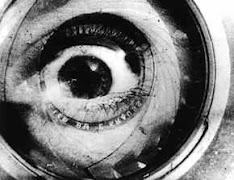JOURNAL FIVE: DUE MARCH 13th
SOUND (chapter five)
Sound is an essential way to construct and define space in film. A film's sound-space is often called its soundscape and is made up of diegetic and non-diegetic sounds. A film soundscape can expand space off-screen or can project the internal space of a character. It can isolate sounds pertinent to the narrative (formalist) or it can record sound as it occurs (realist).
Select a scene and describe its soundscape. How is space constructed through the use of sound? Are the sounds diegetic or non-diegetic? Is the soundscape formally or realistically designed? How does the soundscape propel the narrative and/or comment on characters?




13 comments:
Keston
Diegetic sound is any sound that u hear and you can see the cause of the sound. In relation to a comedy on television such as One and a Half men, the voices of the characters would be an example of diegetic sound. If the characters went to an opera and you see the music being played, this is also considered diegetic sound.
Non Diegetic sound is any sound that is not visible on the screen. In the example of comedies, the sound effects of a crowd laughing is an example of non diegetic sound. It is also used in movies to bring tension. The back ground music in horrors is a perfect example of this.
In the horror film The Hills Have Eyes2, there were many different types of diegetic sounds in numerous scenes. The final scene in which the Recue Officers fight the mutated monster people and free a mating hostage the digestic sound is clearly insinuated. The voices of the characters’ screaming, jumping, and fighting and defeating the mutant enemy are in sync with the action on scene. Though these actions are extremely amplified they are still present to show pain of getting beaten up following triumph and strength in the film. The sounds are realistic in an amplified aspect. Also the dramatic music at the end is of a solute tone as if freedom was won and symbolized the feeling of the characters on screen.
I
Davan said...
n the movie "I Know What You Did Last Summer" the scene where the kids hit a man with a car and tried to put him in the ocean so the cops wouldn't find out. While on the sea port, the music playing in the background is a Non Diegetic sound, for it is formal and not realistic. The music you hear it but didn't The sound of the characters speaking is a Diegetic for it is a realistic sound that you see where it is coming from. The scene is consist of both Non Diegetic and Diegetic sounds.
Amandeep
In the movie SAW 1, I would have to say that there are both diegetic and non-diegetic sounds in this movie. The reason why I say this is because in the part where the guy has a saw, you hear it but you don't see it, and then eventually he comes walking in and you see the saw and you also hear it. So this is basically the reason why I say this movie consist of both diegetic and non-diegetic sounds.
The opening scene of Ridley Scotts "Bladerunner" is a wide shot of what we are shown to be as Los Angeles 2012, in this time we hear the techno style music playing in the background this is known as Non Diegetic sound because it doesnt relate to the images on screen. The Diegetic sounds are the explosions coming off of the pillars and from the flying cars going by.
Space is constructed through the use of sound by the means of creating meaning and giving depth and meaning to a scene. It adds an element to what is being viewed that isn't being that can't be explained in words by one of the characters.
An excellent example of diegetic sounds is in the Denzel Washington film Deja Vu. The opening scene is of a ferry being blown up with numerous passengers and cars on board. The sound of the ship exploading and the items that were once aboard the boat being dropped into the water can be classified as diegetic because it is realistic.
A good example of non-digetic would be in the movie Jaws when they start showing the shark moviing towards the people swimming or in their boats they play the same suspenseful music every time as opposed to the diegetic sound that would be of the water. Which thus makes the music and what it represents formalist because it is done on purpose to evoke mentally an image and a feeling of what is happening or about to happen to the character(s).
The soundscape propels the characters because it alters the scene and makes you have a reaction to what the character is going through. It puts the character at the forefront of the scene and you will either love them or hate them depending on whehter the sound is positive or negative. The soundscape dictates whether that particular scene will beneficial or harmful for that character, which in a way means that the soundscape can be plateau for foreshadowing what is going yo happen.
The movie Eraserhead by David Lynch is a really good movie which uses sound to construct and define space in the film. The director uses both diegetic and non diegetic sounds to bring the story across. I like the scene shown in class where Ereaserhead is walking by the industrial area and suddenly we hear the sound of piece of metal as Eraserhead is crossing the industrial area along. This is a non diegetic sound because the sound is not part of the story; however, it is put on purpose by the director to get a message across. It implies fear and solitude as Ereaserhead is walking along and it keeps you in suspense as he continues to walk by. I like the scene I have just watch on youtube where Eraserhead is about to eat a piece of chicken and he happens to have a very big knife in his hand and suddenly moves the knife towards the man sitting with him at the table and Ereaserhead says, I just…. cut them up like regular chickens, and the man moves slightly back, kind of showing he is afraid of what Eraserhead can do with that knife. The man sitting right next to Eraserhead says…. sure just cut them up like regular chickens and as soon as Eraserhead put the fork on the chicken it starts to move and bleed making a squeegee sound. This is good example of diegetic sound because it is part of the story.
Amandeep
In the movie Texas chainsaw massacre, I would have to say that there are both diegetic and non-diegetic sounds in this movie. The reason why I say this is because in the part where the guy has a saw, you hear it but you don't see it, and then eventually he comes walking in and you see the saw and you also hear it. So this is basically the reason why I say this movie consist of both diegetic and non-diegetic sounds.
The demon scenes in the film Dragon: The Bruce Lee Story, have very interesting uses of non/diegetic sound. The demon howls and screams are diegetic because we associate them with the warrior looking demon on the screen. Other diegetic sounds are the clicking of the demon's armor, the excessively expressed sound of the wind being split by it's spear, and the sound of sparks flying as spear scrapes on the wall. The non-diegetic sound is the scary music that they play to intensify the horror of the scene. That type of music is used in almost every horror flick to set the mood. One of the harder sounds to explain is the beating of the heart. We have no idea whether that sound comes from the kid, the demon, or is just a non-diegetic sound used to indicate fear.
In the movie Bad Boys2 the diegetic sounds matched alot of seens and helped to bring a better feel to the scene. For example when they snuck the hatian mafia headquarters and then a shootout between them brokeout, just before the first shot was fired there was the intro from a hardcore rap song to symbolize the adrenaline and the seriousness of the scene that was being viewed.
A nondiegetic sound would be a sound that doesn't coinside with what is going on as fr as timing goes there is normally a delayed sound after something has happpened or something was announced. For example the introduction of a television talk show host, there is clapping taken place after he/she is announced or feedback from the crowd when the speaker speaks.
Diegetic sound is a sound within the movie. There are many films that carry diegetic sound and non diegetic sound.
An example of non diegetic sound was in American Beauty the family is sitting around at the dinner table and they are all quiet. There is a song that they are playing in their home. And while listening to the song it sort of relates to the relationship each one is having with each other.
An example of diegetic a sound is in the movie Awake with Jessica Alba. It is about a guy that goes under surgery and they had put him under anesthetic. While going through the operation, he realzie that he still can hear everything. He hears the machines thats going on, the people talking and everything that surrounds him in the operating room. Through out the movie he is talking, but its his mind that we are hearing. He is not verbally saying the words. We only hear what he is thinking. That is a goood example of diegetic sound.
In the movie V the usage of diegetic and nondiegetic is used. for an example in the scene when Elisabeth goes to eat the rat her heart beats a little that is diegetic because it is a sound that is coming from within her it is written in the story. There is also another part in the movie where a character is on the bed about to have a baby and you can hear her thoughts that is diegetic sound. Diegetic sound is any sound that is written into the story. And the nondiegetic sound is background noise that is not written into the story.(AD)
Post a Comment